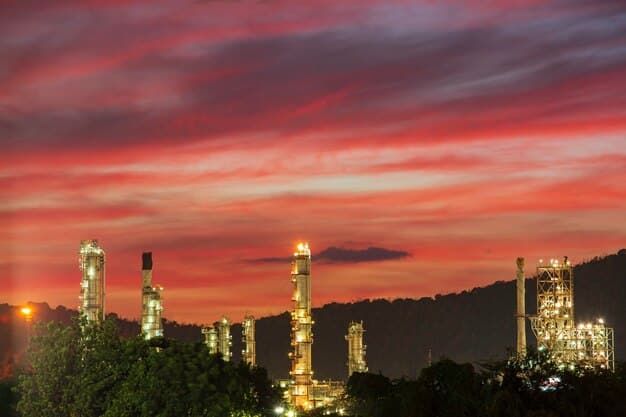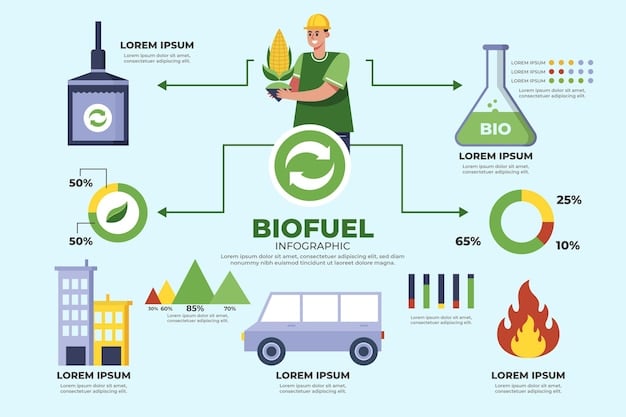Carbon Capture in the US: Are Pilot Projects Finally Paying Off?

Carbon capture technologies are gaining traction in the US as recent pilot projects demonstrate increasing viability, potentially offering a pathway to significantly reduce carbon emissions and combat climate change.
Are carbon capture technologies finally viable? Analyzing recent pilot projects in the US reveals a promising shift in the fight against climate change. As concerns over greenhouse gas emissions escalate, the possibility of capturing carbon at its source is becoming increasingly attractive, sparking renewed interest and investment in innovative solutions.
Understanding Carbon Capture Technology
Carbon capture technology involves capturing carbon dioxide (CO2) emissions from industrial sources such as power plants and factories to prevent them from entering the atmosphere. The captured CO2 is then either stored permanently underground (geological sequestration) or used in various industrial applications.
How Carbon Capture Works
The process typically involves three main stages: capturing, transporting, and storing or utilizing the CO2. Different methods exist for capturing CO2, including pre-combustion capture, post-combustion capture, and oxy-fuel combustion.
- Pre-combustion capture involves converting fuel into a mixture of hydrogen and CO2 before combustion. The CO2 is then separated, and the hydrogen is used as fuel.
- Post-combustion capture removes CO2 from the flue gas after the fuel is burned. This method can be retrofitted to existing power plants.
- Oxy-fuel combustion burns fuel in pure oxygen, producing a flue gas that is primarily CO2 and water vapor, making CO2 capture easier.
Once captured, the CO2 is transported via pipelines, ships, or trucks to storage sites or industrial facilities. Geological sequestration involves injecting the CO2 deep underground into geological formations, such as depleted oil and gas reservoirs or saline aquifers, for permanent storage.
In conclusion, carbon capture technology offers a viable method for mitigating carbon emissions from large, stationary sources by capturing, transporting, and storing CO2, preventing it from entering the atmosphere.
Recent Carbon Capture Pilot Projects in the US
Several pilot projects in the United States are pushing the boundaries of carbon capture technology. These projects vary in scale, technology used, and their specific goals, but they share a common aim: to demonstrate the feasibility and effectiveness of carbon capture in real-world settings.

Petra Nova Carbon Capture Project
One notable example is the Petra Nova Carbon Capture Project, which was attached to the W.A. Parish coal-fired power plant near Houston, Texas. This project used post-combustion capture technology to capture CO2 from the power plant’s flue gas. The captured CO2 was then used for enhanced oil recovery (EOR) in the West Ranch oil field.
- The project aimed to capture approximately 1.6 million tons of CO2 per year.
- It successfully demonstrated the application of carbon capture technology at a commercial scale.
- However, the project faced economic challenges and was eventually suspended.
Illinois Industrial Carbon Capture and Storage Project
Another significant project is the Illinois Industrial Carbon Capture and Storage Project, which captures CO2 from an ethanol plant in Decatur, Illinois, and stores it underground. This project has demonstrated the potential for capturing CO2 from various industrial sources.
These pilot projects, along with others across the US, are providing valuable insights into the technical and economic aspects of carbon capture, informing future deployments and policy decisions.
Technological Advancements Driving Viability
Several technological advancements are enhancing the viability of carbon capture technologies. These innovations are focused on improving efficiency, reducing costs, and expanding the range of applications for captured CO2.
Improved Capture Techniques
Researchers are developing new materials and processes to improve the efficiency and reduce the energy requirements of CO2 capture. For example, advanced solvents and membranes are being designed to selectively capture CO2 from flue gas with minimal energy input.
Carbon Utilization Innovations
Beyond permanent storage, the utilization of captured CO2 is gaining momentum. CO2 can be used to produce various products, including fuels, chemicals, and building materials. This approach not only reduces emissions but also creates new revenue streams, improving the economic viability of carbon capture projects.
- CO2 can be converted into synthetic fuels through chemical processes.
- It can be used to produce polymers and plastics.
- CO2 can be incorporated into building materials like concrete, enhancing their strength and durability.
These technological advancements are making carbon capture more efficient, cost-effective, and sustainable, paving the way for widespread adoption.

Analyzing the Economic Factors
The economic viability of carbon capture technologies is a critical factor in their widespread adoption. The costs associated with capturing, transporting, and storing CO2 can be substantial, but ongoing efforts are focused on reducing these costs and creating new economic opportunities.
Cost Reduction Strategies
Several strategies are being employed to reduce the costs of carbon capture. These include improving capture efficiency, developing more cost-effective materials, and optimizing the design and operation of carbon capture facilities. Economies of scale, as more large-scale projects are deployed, will also contribute to cost reductions.
Government Incentives and Policies
Government incentives and policies play a crucial role in promoting the deployment of carbon capture technologies. Tax credits, grants, and regulations can help offset the initial costs of these projects and create a more favorable investment climate.
Ultimately, the economic viability of carbon capture technologies will depend on continued innovation, supportive government policies, and the development of robust markets for captured CO2.
Environmental Impact and Sustainability
While carbon capture technologies offer a promising solution for reducing greenhouse gas emissions, it is essential to consider their environmental impact and sustainability. A comprehensive assessment must address potential environmental risks and benefits throughout the entire carbon capture lifecycle.
Potential Environmental Risks
One concern is the potential for CO2 leakage from geological storage sites. While properly selected and managed storage sites can provide secure long-term storage, monitoring and risk assessment are crucial to prevent any leakage that could negate the climate benefits of carbon capture.
Benefits of Carbon Capture
The primary benefit of carbon capture is the reduction of greenhouse gas emissions. By preventing CO2 from entering the atmosphere, these technologies can help mitigate climate change and its associated impacts.
- Reduced greenhouse gas emissions contributing to climate change.
- Opportunities for industrial facilities to operate more sustainably.
- Can be adapted to various industrial sources, including power plants and factories.
A comprehensive approach to carbon capture, considering both its potential risks and benefits, is essential to ensure its long-term sustainability and environmental effectiveness.
The Future of Carbon Capture in the US
The future of carbon capture in the United States looks promising. With ongoing technological advancements, supportive government policies, and increasing awareness of the need to address climate change, carbon capture technologies are poised to play a significant role in the country’s efforts to reduce emissions and transition to a cleaner energy future.
Policy Support and Investment
Continued policy support and investment are critical to drive the widespread deployment of carbon capture technologies. Tax credits, research funding, and regulatory frameworks can create a more favorable environment for these projects.
Integrating with Renewable Energy
Carbon capture technologies can be integrated with renewable energy sources to create a more sustainable energy system. For example, bioenergy with carbon capture and storage (BECCS) involves capturing CO2 from biomass-fueled power plants and storing it underground, effectively removing CO2 from the atmosphere.
As carbon capture technologies continue to advance and become more cost-effective, they are likely to become an integral part of the US’s strategy for achieving its climate goals and creating a sustainable future.
| Key Point | Brief Description |
|---|---|
| 🌱 Carbon Capture | Captures CO2 from sources like power plants to reduce atmospheric emissions. |
| 💰 Economic Viability | Depends on cost reduction strategies and supportive government policies. |
| 🔄 CO2 Utilization | Using captured CO2 in products like fuels, chemicals, and building materials. |
| 🌎 Environmental Impact | Balancing emission reductions with monitoring for potential CO2 leakage. |
Frequently Asked Questions
▼
Carbon capture technology involves capturing carbon dioxide emissions from industrial sources to prevent their release into the atmosphere, mitigating climate change.
▼
The process includes capturing CO2, transporting it via pipelines, and storing it deep underground in geological formations or using it for industrial applications.
▼
Projects like Petra Nova in Texas and the Illinois Industrial Carbon Capture and Storage Project demonstrate the application of carbon capture on a commercial scale.
▼
High costs associated with capturing, transporting, and storing CO2 are significant hurdles, but government incentives and technological advances can help reduce these costs.
▼
The future looks promising with policy support, technological advancements, and integration with renewable energy sources, positioning carbon capture for a significant role.
Conclusion
In conclusion, the analysis of recent pilot projects in the US suggests that carbon capture technologies are indeed becoming increasingly viable, offering a crucial tool in the fight against climate change. While challenges remain, ongoing advancements and supportive policies pave the way for a cleaner, more sustainable future.





